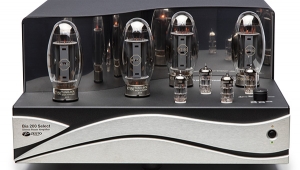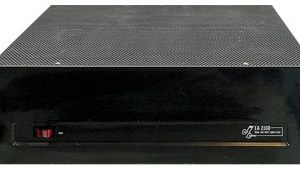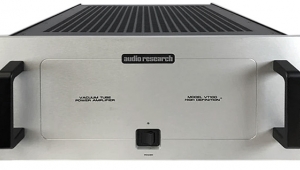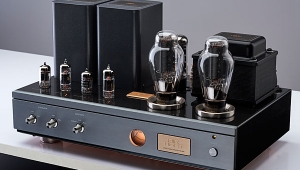| Columns Retired Columns & Blogs |
Quicksilver Audio Horn Mono monoblock power amplifier
Single-ended triode (SET) amplifiers are typically paired with horn loudspeakers, for good reason: most SETs produce very low power, so to get acceptable loudness you need a highly sensitive speaker, which means horns. Similarly, horn owners are often advised that the best amplifier for their speakers is a SET. Certainly, the horn-SET combination can be magical, but, in my experience, SETs are not the only type of amplifier that can sound good with horns.
 Mike Sanders of Quicksilver Audio agrees. He's a fan of horns, but his preferred amplifier design is push-pull rather than single-ended. According to Sanders, the reason for push-pull amplifiers often not being at their best with horns is that they're normally optimized for the higher gain necessary to drive "standard" lower-sensitivity speakers, and the result with horns is too high a noise level. He also feels that it's vitally important to keep distortion very low in the critical below-0.5W range, in which horns work most of the time. He initially designed a push-pull amplifier meeting these criteria to drive his own horn-based system, and he liked the results. He built a few more for friends with horns, and the response was sufficiently positive that he decided to turn it into a commercial product: the Horn Mono.
Mike Sanders of Quicksilver Audio agrees. He's a fan of horns, but his preferred amplifier design is push-pull rather than single-ended. According to Sanders, the reason for push-pull amplifiers often not being at their best with horns is that they're normally optimized for the higher gain necessary to drive "standard" lower-sensitivity speakers, and the result with horns is too high a noise level. He also feels that it's vitally important to keep distortion very low in the critical below-0.5W range, in which horns work most of the time. He initially designed a push-pull amplifier meeting these criteria to drive his own horn-based system, and he liked the results. He built a few more for friends with horns, and the response was sufficiently positive that he decided to turn it into a commercial product: the Horn Mono.
A low-gain Mini Mono?
Sam Tellig has written favorably about the Mini Mono (see Stereophile, March 2001, Vol.24 No.3), a Quicksilver amplifier that bears some resemblance to the Horn Mono but costs a third less ($998/pair). A superficial look at the two amps' specifications might lead one to describe the Horn Mono as the "low-gain version of the Mini Mono," which would make it difficult to justify the difference in price. However, according to Mike Sanders, the differences between the amps go far beyond the differences in gain. (He did build a Mini Mono that just had lower gain, but didn't like its sound with horns.)
The Horn Mono uses a number of different components and has a substantially different circuit from the Mini Mono's. The Horn Mono has a larger output transformer, which allows for greater power delivery in the bass: full power (25W) is available down to 20Hz for the Mini Mono, to 10Hz for the Horn Mono. While both amplifiers use the same output tubes (Tesla EL34s as supplied; auto-biasing allows use of several other types of tubes), the rest of the tube complement is different. The Mini Mono uses a single 12AX7 for driver and gain, whereas the Horn Mono uses a 7247, a more expensive dual-function tube that's half 12AX7 and half 12AU7, the 12AX7 part being used for gain, the 12AU7 as the driver. The Horn Mono's driver configuration permits lower output impedance and greater voltage swing—both desirable qualities.
The Horn Mono has a gereater level of overall negative feedback (20dB vs 10dB for the Mini Mono), which results in about a tenth the distortion. The use of higher negative feedback is likely to raise eyebrows in some audiophile quarters, but Sanders feels that negative feedback is neither good nor bad in itself; its effect depends on the exact amount of feedback and how it's applied in a given circuit. Too little feedback can result in excessive distortion; too much impairs stability.
Other differences from the Mini Mono include a larger, chrome-plated chassis, and heavy-duty, high-quality speaker connectors. The Horn Mono is quite attractive in a way that recalls the Dynaco tube amplifiers of yore, its chrome plating adding a touch of hi-tech luxury without elevating the product into the class of "audio jewelry." Like all Quicksilver Audio products, the Horn Mono is hand-wired, and Mike Sanders personally checks each amplifier before it leaves the factory. The build quality is excellent.
- Log in or register to post comments



































